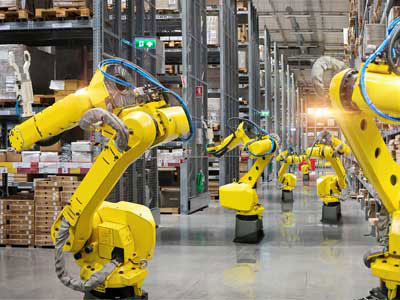Key Takeaway
The latest innovations in industrial robotics focus on enhancing efficiency and precision. Collaborative robots, or cobots, are designed to work alongside humans, improving productivity and safety. AI-powered robots use machine learning to adapt to new tasks, making them more versatile. Advanced vision systems allow robots to perform complex tasks with greater accuracy. Additionally, mobile robots are now more autonomous, navigating factory floors independently. These innovations in industrial robotics are transforming manufacturing by increasing automation, reducing errors, and improving overall operational efficiency.
AI and Machine Learning Integration
AI and machine learning integration revolutionizes industries by automating processes, enhancing decision-making, and predicting trends with unprecedented accuracy. From predictive maintenance in manufacturing to personalized recommendations in e-commerce, these technologies optimize efficiency and customer satisfaction. By harnessing vast data sets, AI and machine learning empower businesses to innovate and adapt swiftly in a rapidly evolving market landscape. Embracing these advancements not only streamlines operations but also unlocks new opportunities for growth and competitive advantage, marking a pivotal shift towards smarter, more agile enterprises.

Advanced Sensor Technologies
Advanced sensor technologies are at the heart of modern industrial robots, giving them the ability to perceive and interact with their environment effectively. Innovations like 3D vision systems, force-torque sensors, and lidar have revolutionized the field. These sensors provide robots with precise control and situational awareness, enabling them to handle delicate tasks and operate in dynamic environments. For instance, 3D vision sensors allow robots to accurately identify and pick up objects of various shapes and sizes, significantly enhancing automation in assembly lines. This precision is crucial for improving productivity and reducing errors in manufacturing processes.
Force-torque sensors are another critical innovation. They enable robots to adjust their grip and apply the correct amount of pressure, which is essential for tasks requiring fine motor skills. This capability is vital in applications such as electronic component assembly, where even a slight mishandling can cause significant issues. By integrating these advanced sensors, robots can perform tasks that were previously impossible or too risky for automation, pushing the boundaries of what industrial robots can achieve. The continuous development of sensor technologies ensures that industrial robots remain at the forefront of efficiency and precision in various industries.
Collaborative Robots
Collaborative robots, or cobots, are transforming how humans and machines work together in industrial settings. Unlike traditional industrial robots that operate in isolated areas, cobots are designed to share the workspace with human workers, enhancing productivity and flexibility. Equipped with advanced safety features, such as sensors and automatic shut-off mechanisms, cobots can detect and prevent potential accidents, ensuring a safe working environment. These robots are user-friendly and can be easily programmed, making them accessible even to non-experts. This ease of use is a significant advantage in industries like electronics, automotive, and healthcare.
Cobots assist in various tasks, from assembly and packaging to quality inspection and even surgical procedures. Their versatility and safety features make them ideal for applications where close human-robot collaboration is necessary. For instance, in the electronics industry, cobots can handle delicate components with precision, reducing the risk of damage. In healthcare, they assist surgeons with complex procedures, providing steady and precise movements. The adoption of cobots is growing rapidly, as they offer a practical solution to labor shortages and enhance operational efficiency without compromising safety.
Autonomous Navigation
Autonomous navigation is a game-changer in industrial robotics, enabling robots to move and operate independently within a factory or warehouse. Technologies like simultaneous localization and mapping (SLAM) and advanced GPS systems allow robots to navigate complex environments without human guidance. Autonomous mobile robots (AMRs) can transport materials, manage inventory, and deliver goods with high precision and efficiency. These robots use real-time data from sensors and cameras to avoid obstacles and optimize their routes, streamlining logistics and reducing the need for manual intervention.
The implementation of autonomous navigation in industrial robots significantly enhances overall operational efficiency. By reducing the dependency on human workers for routine tasks, companies can allocate their workforce to more strategic roles. This technology also minimizes errors and delays associated with manual handling. For example, in a warehouse, AMRs can efficiently manage the movement of goods, ensuring timely delivery and accurate inventory management. The ability to operate independently in dynamic environments makes autonomous navigation a critical component of modern industrial automation, driving productivity and cost savings.
Human-Robot Interaction
Human-robot interaction (HRI) is pivotal for the future of industrial robotics, focusing on making robots more intuitive and easier for humans to work with. Innovations in HRI, such as natural language processing (NLP) and gesture recognition technologies, enable robots to understand and respond to human commands more effectively. This leads to smoother collaboration and reduces the learning curve for operators, making it easier for them to integrate robots into their workflows. Additionally, augmented reality (AR) interfaces are being developed to provide real-time guidance and feedback to workers interacting with robots.
These advancements ensure that robots can assist humans more effectively, creating safer and more efficient workplaces. For instance, NLP allows operators to give voice commands to robots, streamlining complex tasks and reducing the need for extensive training. Gesture recognition adds another layer of interaction, where simple hand movements can control robotic actions. AR interfaces offer visual aids that help workers understand robot functions and troubleshoot issues quickly. By improving HRI, the industry can foster a more collaborative environment where humans and robots work seamlessly together, enhancing productivity and job satisfaction.
Conclusion
Industrial robotics continues to evolve with groundbreaking innovations that redefine automation in manufacturing. From collaborative robots enhancing workplace safety to AI-driven systems optimizing production efficiency, these advancements promise transformative impacts. As industries embrace smarter, more adaptable robotic solutions, the future of manufacturing looks increasingly automated and efficient, driven by continuous technological breakthroughs.
